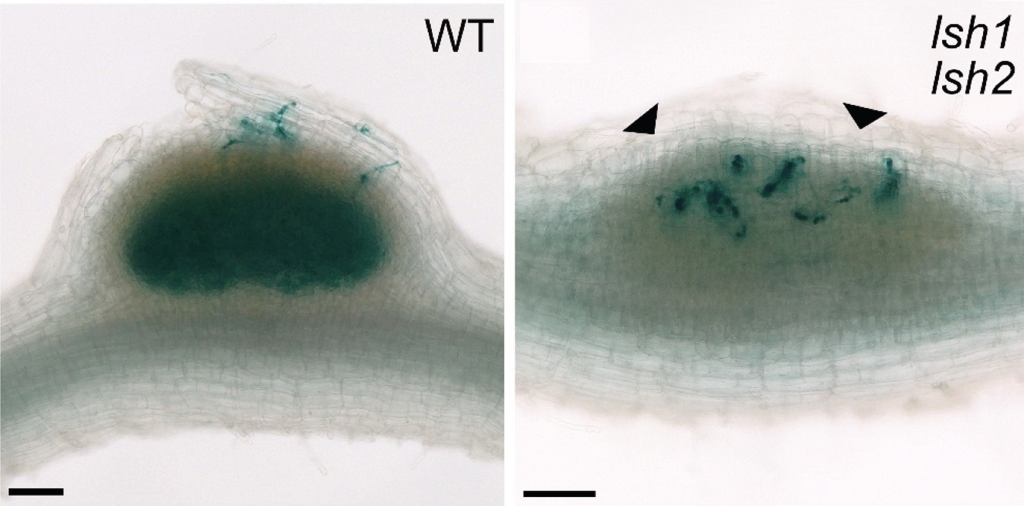ENSA scientists are part of research that has identified two crucial genetic factors needed to produce specialised root organs that can accommodate nitrogen-fixing bacteria in legumes such as peas and beans.
In a surprising twist, the developmental regulators that confer the identity of these organs – known as nodules – belong to a transcription factor family more commonly associated with defining the shapes of stems, flowers and leaves. These factors are broadly conserved in plants, indicating their nodule-specifying function in legumes is a more recent innovation.
This significant discovery brings us one step closer to potentially engineering non-legume cereal crops like wheat, rice and maize to develop root nodule organs to host nitrogen fixing bacteria and reduce our reliance on industrial nitrogen fertilisers produced via the energy consuming Haber Bosch Process.
This latest research, led by Dr Katharina Schiessl, a Career Development Fellow at the Sainsbury Laboratory Cambridge University (SLCU), builds on her earlier findings that the same genetic programme underlying lateral root development also underpins root nodule initiation.
Dr Schiessl’s discovery takes us a step further along the pathway of understanding how this symbiotic relationship is established between beneficial soil bacteria and legumes and how it is maintained to support biological nitrogen fixation. And with the discovery that legumes are recycling genetic programmes that are used by many species of plants, including cereals, the engineering task could be a whole lot less complicated.
Published in Current Biology, “Light-sensitive short hypocotyl genes confer symbiotic nodule identity in the legume Medicago truncatula”, was a collaboration between scientists working at SLCU, the Crop Science Centre, John Innes Centre, University of Freiburg, Oklahoma State University and Royal Botanic Gardens, Kew.
Their research identified two genetic factors, named LIGHT-SENSITIVE SHORT HYPOCOTYL (LSH1/LSH2), promote the production of specialised root cells that are required to make the developing nodule structure a suitable home for the nitrogen fixing bacteria – conferring nodule organ identity.
“We show two members of the LIGHT SENSITIVE SHORT HYPOCOTYL (LSH) transcription factor family are functioning as regulators of nodule organ identity,” Dr Schiessl said. “LSH1/LSH2 enlist a programme in a root tissue called the cortex that facilitates the formation of a group of cells that are infectable and habitable by the bacteria early during nodule development. At the molecular level, this involves inhibiting the default lateral root program, controlling the dynamics of the plant hormones auxin and cytokinin, and promoting the expression of the previously identified key nodule organ identity regulators NODULE ROOT1/2 and Nuclear Factor Y-A1.”
In summary, the research shows that root tissues can be reprogrammed by pre-existing shoot programmes and includes a proposed model for specification of nodule development: cytokinin activation of NIN expression initiates the nodule primordium through induction of LBD16, which activates local auxin biosynthesis to drive cell divisions in a manner comparable to lateral root initiation. Activation of LSH genes then confers nodule organ identity.
“This finding that legumes are harnessing pre-existing developmental regulators and their associated downstream networks to generate purpose-built organs with novel forms and functions is essential for future engineering of biological nitrogen fixation, Dr Schiessl said.”
Dr Schiessl’s newly formed research group at SLCU is continuing to explore the regulatory pathways and cellular processes of coloniser-induced organ development, studying symbiotic root nodules and parasitic galls.
The lab pursued this work as part of Enabling Nutrient Symbioses in Agriculture (ENSA) an international research project that aims to transform how crop plants acquire nutrients, such as nitrogen and phosphorus, achieving a radical shift away from the application of inorganic fertilisers to harness naturally occurring plant processes with support from the Bill & Melinda Gates Agricultural Innovations.
Established in 2012, ENSA is a partnership between the University of Cambridge Crop Science Centre, Aarhus University, University of Oxford, Albert-Ludwigs-Universität Freiburg, NIAB, Université Toulouse III Paul Sabatier, University of Illinois and Wageningen University.
Reference
Tak Lee, Martina Orvosova, Morgane Batzenschlager, Marcelo Bueno Batista, Paul C. Bailey, Nadia A. Mohd-Radzman, Aram Gurzadyan, Naomi Stuer, Kirankumar S. Mysore, Jiangqi Wen, Thomas Ott, Giles E.D. Oldroyd, Katharina Schiessl (2024) Light-sensitive short hypocotyl genes confer symbiotic nodule identity in the legume Medicago truncatula. Current Biology

